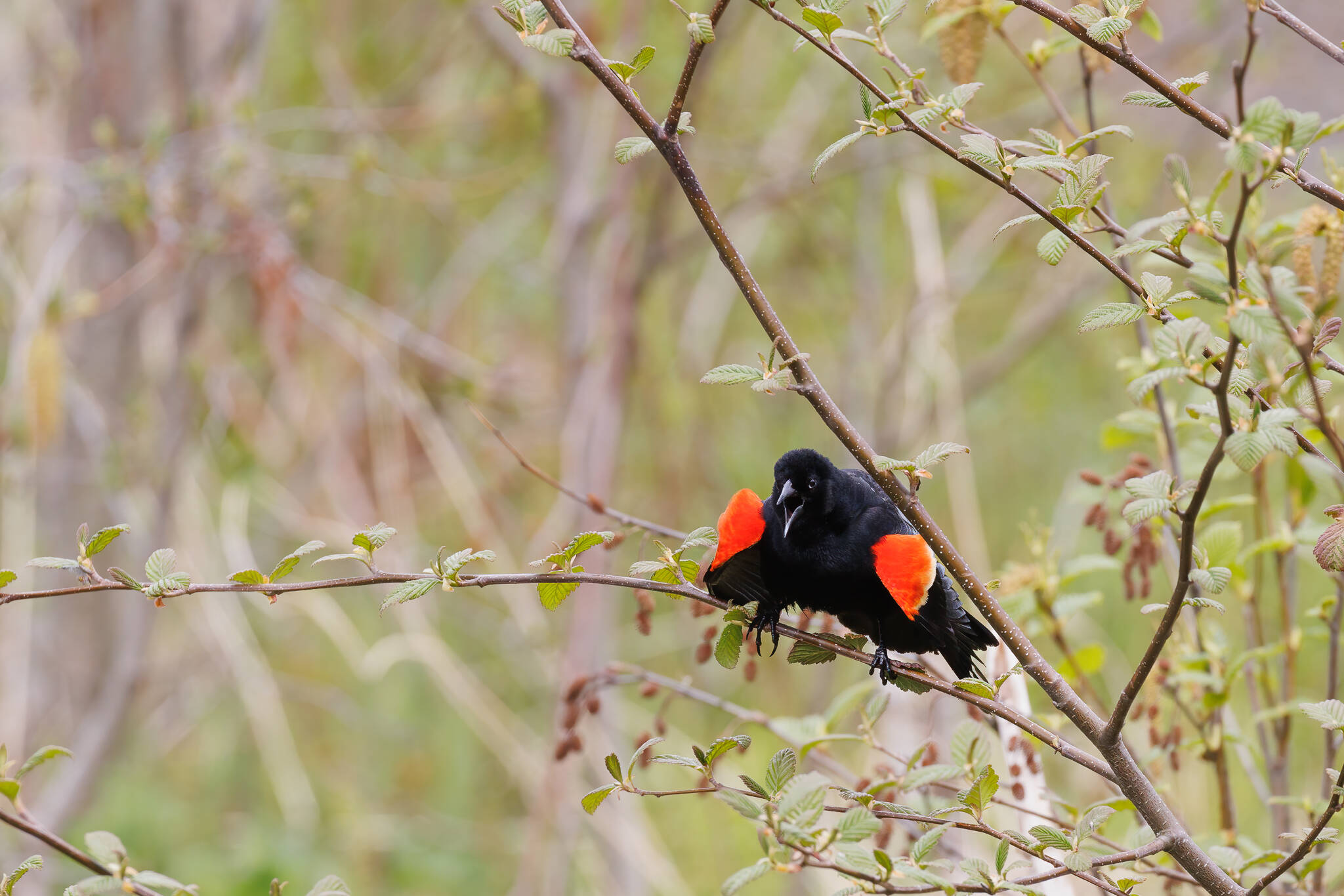By Mary F. Willson
Nestled in between an industrially ravaged section of the Lemon Creek valley and the police station is a small gem of wildlife habitat. Known as Kingfisher Pond, in the early 2000s it was reclaimed from a gravel pit and restored to suitable conditions for a variety of wildlife species by City and Borough of Juneau and U.S.Fish and Wildlife Service. Big kudos to whoever had the foresight to see the value of this habitat island in the midst of what passes for civilization! Over 40 bird species have been recorded to use the pond at some time. Birdwatchers and photographers stop by frequently, to see what’s happening there. Almost always, something is!
After a very long hiatus, I went there in mid-May. Things were quite lively, even though I didn’t get there until late morning. Two male red-winged blackbirds had staked out territories, one at each end of the pond. Each one had a female — and a later visit, with very sharp-eyed companion, showed that one male had two females. It should be possible to confirm this on another visit, when chicks are being fed and there are busy trips with food. On a sunny day a bit later, we watched an excited male zoom into some low shrubs above the pond edge, where the ensuing flurry of activity showed us that he and a hidden female were copulating there. Later, the two adult males angrily chased off an immature male that was checking out the pond (and no doubt the females too).
Several of the Audubon Society’s nest boxes had been claimed by pairs of tree swallows. But I think there were some extra swallows around, maybe hoping to usurp a box or a mate. Pretty soon, the tree swallows swooping over the pond were joined by small violet-green swallows, all snacking on flying insects and occasionally seeming to take a bug (?or a drink) off the water surface. A few days later, a couple of barn swallows joined the throng.
The alders surrounding the pond were busy places. Lots of yellow-rumped warblers were gleaning bugs from the emerging foliage and darting out on elegant maneuvers to catch tiny flying insects. A male Wilson’s warbler and a male yellow warbler searched the young leaves of an elderberry bush. A few laggard golden-crowned sparrows and white-crowned sparrows still foraged on the ground, although most had departed on their journeys. A song sparrow sang from a thicket. Two savannah sparrows scuttled around the pond edge, under the trees—not the usual place to see this species!
A belted kingfisher might appear (to validate the pond’s name…) but the pond does not offer nice mud cliffs for its nest cavities. Mallards, green-winged teal, and ring-neck ducks came and went—and so did I. If I went back another time, it would be a little different, depending on time of day, weather, season and everything else.
It’s not just the birds, however. Otters sometimes visit the pond; we watched one snack on small fish and undulate smoothly underwater below the edge of the platform. That critter could be a threat to blackbird eggs and nestlings in the nests placed low in the sedges. A beaver lodge can be seen in the adjacent, large pond, and old cuttings are visible under the alders, and an old beaver trail crosses from the big, silty pond into Kingfisher Pond, but I’m told that the beavers have moved to another site. However, there is another lodge just down the shore of the big pond and we saw some small recent beaver cuttings near the shore.
In quiet corners of open water, whirligig beetles were living up to their name—zipping in erratic circles. These little beetles are predators and scavengers of small invertebrates, and they are said to forage mainly at night.
They can dive, carrying a bubble of air for a ready supply of oxygen. The long front pair of legs is used for capturing prey, and the shorter second and third pairs are for locomotion—the third pair mostly for power and the second pair for steering. They have four eyes: one pair above the water surface and one pair below, but much prey detection is done by the short antennae that sense vibrations of prey movement.
We often see them in rafts of several or many individuals all slowly swimming around. These are not mating swarms. The aggregations appear to facilitate early warning of an approaching threat; large groups (with more eyes looking) detect an approaching predator at a greater distance than small groups do. Groups respond to a perceived threat by swimming more agitatedly, faster and with more zig-zags. The reaction is very quick—the waves propagated by the most vigilant beetles are felt by the others, and within a few seconds the whole group is whirling madly. This makes it harder for a predator to zero in on any one individual, especially when the beetles are in large, dense groups. If a predator does attack a beetle, the victim can secrete a noxious fluid that is known to deter predatory fish (and maybe others too).
Whirligigs spend the winter buried in mud at the bottom of the pond; presumably they then have lowered metabolic rates and low oxygen needs. They can fly to new habitats if their pond becomes unsuitable.
• Mary F. Willson is a retired professor of ecology. “On the Trails” appears every Wednesday in the Juneau Empire.

